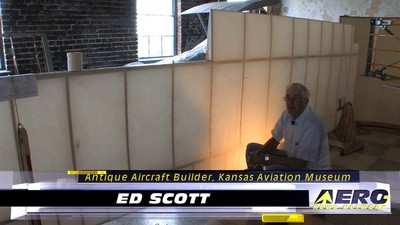Mon, Mar 22, 2010
The Kansas Aviation Museum is more than just a showcase for
Wichita’s rich aviation history; it is history. Listed on the
National Register of Historic Places, the museum is housed in
Wichita’s original municipal airport terminal. Dedicated on
March 31st, 1935, the Wichita Municipal Airport served as a major
mid-continent stopover for commercial operations as the last stop
before crossing the Rockies to Denver or Los Angeles. At its peak
in 1944, the airport was one of the busiest in the nation with
take-offs or landings occurring every 90 seconds. Wandering the
museum, visitors are immediately transported back to the glory days
of aviation, surrounded by grand terrazzo halls and art-deco
design. Nearly every aviation and entertainment legend of the era
roamed the buildings halls, from Howard Hughes and Fred Astaire to
Charles Lindbergh and Amelia Earhart.

With the United States entry into World War II, an explosion in
aviation manufacturing in Wichita altered the fate of the building.
Tens of thousands of aircraft were built in Wichita for the War
effort and the airport became a central location for flight-testing
and military supervision. On September 16th, 1947, the government
established the United States Air Force as a separate element of
the United States armed forces; by 1951, the USAF took over the
Wichita Municipal Airport for pilot training on B-47s, B-36s, and
eventually B-52s. For the next 30 years, the USAF and the Kansas
Air National Guard used the location as Building One of the
McConnell Air Force Base. In 1984, however, the USAF abandoned the
building.

For six years, the historical location sat empty and partially
gutted; after being leased by the City of Wichita to the Wichita
Aeronautical Historical Association in the late 1980s, volunteers
painstakingly began restoration efforts that continue to this day.
On April 19th, 1991, the Kansas Aviation Museum officially opened
to the public displaying an extraordinary collection of Kansas and
national aviation history.

The museum houses a world-class collection of rare aircraft,
aircraft engines, and archive documents including the entirety of
the original FAA identification cards from 1927 until 1994. In
addition, volunteers have successfully restored such one-of-a-kind
aircraft as a 1934 Stearman Model 73/Navy NS-1 Trainer and 1927
Swallow. Restoration continues through the astonishing efforts of
the museums dedicated staff and generous donations from historical
and aviation enthusiasts alike.
More News
Option Approach An approach requested and conducted by a pilot which will result in either a touch-and-go, missed approach, low approach, stop-and-go, or full stop landing. Pilots >[...]
"Emirates is already the world's largest Boeing 777 operator, and we are expanding our commitment to the program today with additional orders for 65 Boeing 777-9s. This is a long-t>[...]
(Pilot) Reported That There Was A Sudden And Violent Vibration Throughout The Airplane That Lasted Several Seconds Analysis: The pilot was returning to his home airport at an altit>[...]
“This recognition was evident during the TBMOPA Annual Convention, where owners and operators clearly expressed their satisfaction with our focus on customer service, and enc>[...]
Overhead Maneuver A series of predetermined maneuvers prescribed for aircraft (often in formation) for entry into the visual flight rules (VFR) traffic pattern and to proceed to a >[...]
 ANN's Daily Aero-Term (11.19.25): Option Approach
ANN's Daily Aero-Term (11.19.25): Option Approach Aero-News: Quote of the Day (11.19.25)
Aero-News: Quote of the Day (11.19.25) NTSB Final Report: Sting Sport TL-2000
NTSB Final Report: Sting Sport TL-2000 Aero-News: Quote of the Day (11.20.25)
Aero-News: Quote of the Day (11.20.25) ANN's Daily Aero-Term (11.20.25): Overhead Maneuver
ANN's Daily Aero-Term (11.20.25): Overhead Maneuver





